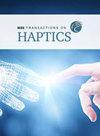Exploring Perceptual Intensity Properties Using Electrotactile Stimulation on Fingertips
IF 2.4
3区 计算机科学
Q2 COMPUTER SCIENCE, CYBERNETICS
引用次数: 0
Abstract
Understanding electrotactile parametric properties is a crucial milestone in achieving intuitive haptics. Perceptual intensity is a primary property, but its exploration remains challenging due to subjectivity. To address this problem, this study conducted two experiments on fingertips and proposed two metrics based on significant findings. Experiment 1 found a significant linear relationship (R利用指尖的电触觉刺激探索感知强度特性。
理解电活动参数特性是实现直观触觉的重要里程碑。感知强度是一种主要性质,但由于主观性,其探索仍然具有挑战性。为了解决这个问题,本研究在指尖上进行了两次实验,并根据重要发现提出了两个指标。实验1发现脉冲幅度(PA)和脉冲宽度(PW)在对数平面上存在显著的线性关系(R2=0.981),并提出了参数强度(PI)的度量来估计参数的强度。在实验2中,使用0至10的量表来定义和测量主观强度(SI)。基于PI与实测SI之间的线性关系(RR2>0.78),推导了SI的度量模型(SI模型),提出了一种校准方法,并验证了其预测精度。11.2%的平均RMSE表明准确率接近8.7%的主观判断误差。受试者和四种不同电极皮肤状况(ESC)的结果一致。该研究结果为SI的预测和调节提供了理论支持,对电活动反馈具有重要意义。
本文章由计算机程序翻译,如有差异,请以英文原文为准。
求助全文
约1分钟内获得全文
求助全文
来源期刊

IEEE Transactions on Haptics
COMPUTER SCIENCE, CYBERNETICS-
CiteScore
5.90
自引率
13.80%
发文量
109
审稿时长
>12 weeks
期刊介绍:
IEEE Transactions on Haptics (ToH) is a scholarly archival journal that addresses the science, technology, and applications associated with information acquisition and object manipulation through touch. Haptic interactions relevant to this journal include all aspects of manual exploration and manipulation of objects by humans, machines and interactions between the two, performed in real, virtual, teleoperated or networked environments. Research areas of relevance to this publication include, but are not limited to, the following topics: Human haptic and multi-sensory perception and action, Aspects of motor control that explicitly pertain to human haptics, Haptic interactions via passive or active tools and machines, Devices that sense, enable, or create haptic interactions locally or at a distance, Haptic rendering and its association with graphic and auditory rendering in virtual reality, Algorithms, controls, and dynamics of haptic devices, users, and interactions between the two, Human-machine performance and safety with haptic feedback, Haptics in the context of human-computer interactions, Systems and networks using haptic devices and interactions, including multi-modal feedback, Application of the above, for example in areas such as education, rehabilitation, medicine, computer-aided design, skills training, computer games, driver controls, simulation, and visualization.
 求助内容:
求助内容: 应助结果提醒方式:
应助结果提醒方式:


